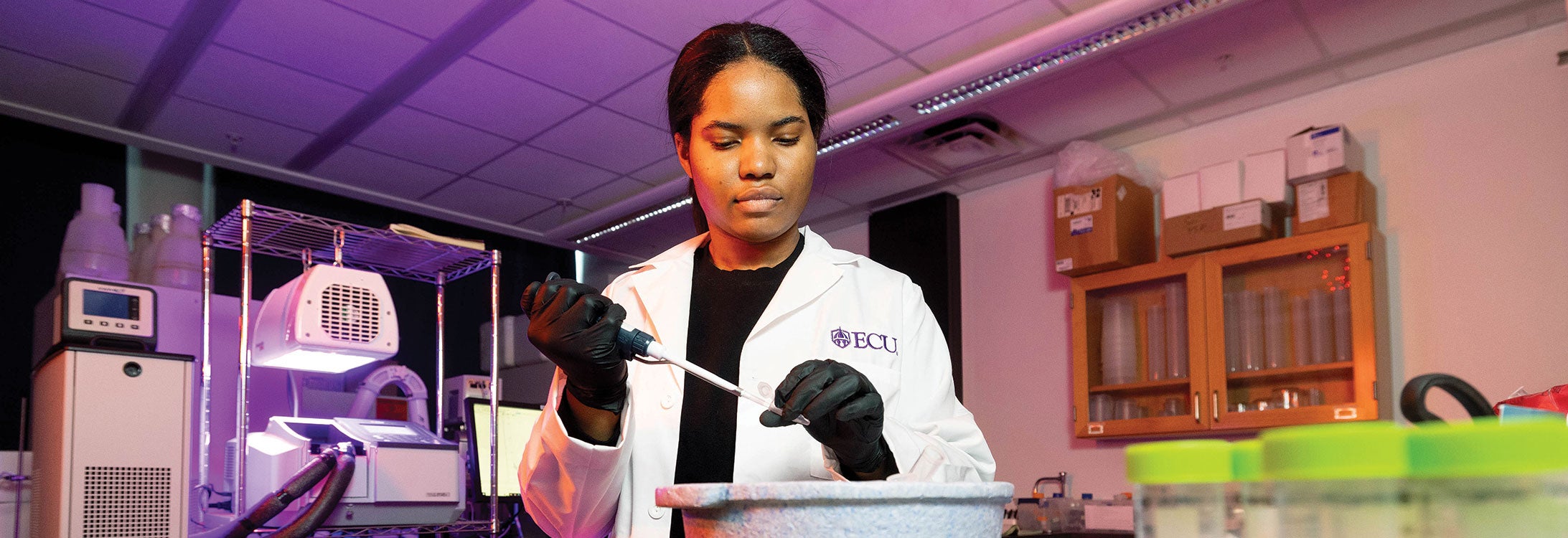The Blueprint
With R1 Status, ECU sets the course for the future of university research
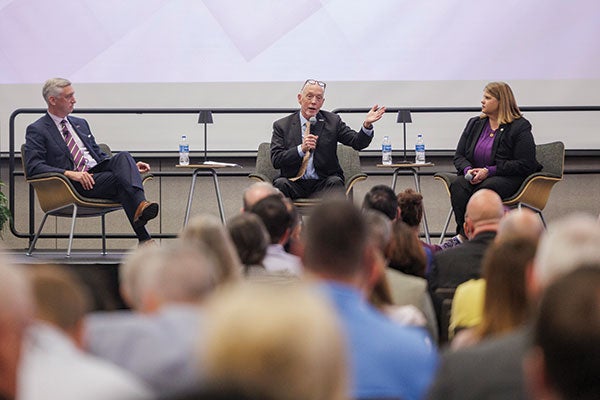
Chancellor Philip Rogers, left, moderates an April 2 panel discussion on the future of top-tier U.S. based research universities with Ted Mitchell, center, president of the American Council on Education, and Sharon Paynter, ECU’s chief innovation and engagement officer and interim chief research officer. (Photo by Steven Mantilla)
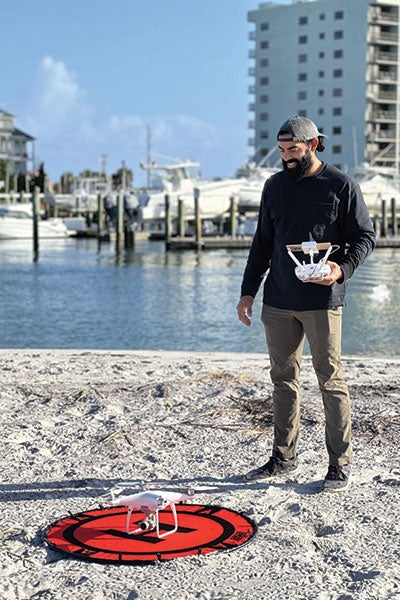
Former geography graduate student Michael Moody prepares to fly a drone to survey Sugarloaf Island in Carteret County, North Carolina. The state allocated $2 million to restore the shrinking island. (Contributed photo)
Somewhere above the shifting sands of the Outer Banks, a drone hums in the Atlantic winds, documenting the migration of North Carolina’s fragile barrier islands.
On the state’s coastal plain, a farmer tracks irrigation patterns with real-time analytics, coaxing life from the soil with the help of precision agriculture.
Meanwhile, in a Greenville lab, a centrifuge spins as a computer crunches gigabytes of genomic data, illuminating potential new treatments for chronic diseases.
These are not isolated stories. They’re interconnected strands in the tapestry of research emerging from East Carolina University, a public institution once known primarily for its teaching mission and now as a national research powerhouse.
This spring, that transformation received its most significant endorsement yet. ECU was officially designated an R1 university by the Carnegie Foundation for the Advancement of Teaching and the American Council on Education — an elite classification placing it among the top 5% of research universities in the United States. For an institution whose heart has always beat in service to North Carolina, the milestone is as symbolic as it is practical: proof that community commitment and world-class research can be mutually beneficial.
R1 designation comes when two thresholds are met: more than $50 million in annual research expenditures and more than 70 research doctoral degrees granted annually. But the spectrum of research excellence is much broader than just these two measures. Faculty develop expertise over many years. Hours spent writing articles, creating art and music, in classrooms and labs, and doing fieldwork allow them to expand the boundaries of knowledge and innovation. When their work is shared with their peers and the world around them, they are fulfilling the most central role of an R1 university, and this is what makes funders take note and gets students ready to learn from top-tier research faculty.
R1 universities are known for having broad academic and research portfolios housed in major research centers and institutes with robust graduate programs. They emphasize peer-reviewed publications, grant funding and pushing the boundaries of knowledge. But U.S. research universities also grapple with balancing tradition and innovation, addressing cost of attendance and responding to market demand and workforce needs. Future R1 institutions may lean into the practical value that defines the ECU approach. “For me, why create a blueprint for the new American university when it’s right here?” said Ted Mitchell, president of the American Council on Education, speaking at a campus celebration in April. “This is the university that is creating the model for what the American research university will be in the future. Period. End.”
A mission that matters
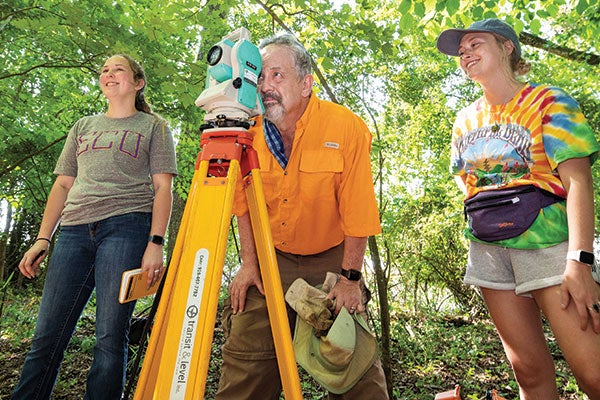
Anthropology professor Charles Ewen, center, works with students Mackenzie Mulkey and Regina Wheeler to locate and document gravesites at an abandoned cemetery in Ayden, North Carolina. (Photo by Rhett Butler)
ECU is not the kind of place that chases prestige for prestige’s sake. Its roots run through eastern North Carolina — an often overlooked, underserved swath of the American South where tobacco fields and tidal marshes stretch across the horizon. From the beginning, ECU existed to serve this region: to educate its youth, heal its sick and fortify its communities.
So when Chancellor Philip Rogers says the university’s rise as a research institution is “a direct reflection of our mission — advancing student success, public service and regional transformation,” it’s more than rhetoric. The R1 status, he says, is not an endpoint but a springboard. “This milestone will open doors to more opportunities for collaboration, discovery and academic excellence,” he says.
With $67.1 million in research expenditures last year alone and $326.9 million in grant awards over the past four, ECU is not just competing with elite institutions, it is redefining the value proposition of public higher education. It’s carving a different path defined not by endowment size or historic pedigree but by practical impact and community rooted innovation.
“Our research is about solving real-world problems,” says Sharon Paynter, ECU’s chief innovation and engagement officer and interim chief research officer. “We’re talking about new treatments for chronic illness, strategies for rural economic development, ways to protect and sustain our coastlines. This is research that matters.”
Faculty leadership, student discovery
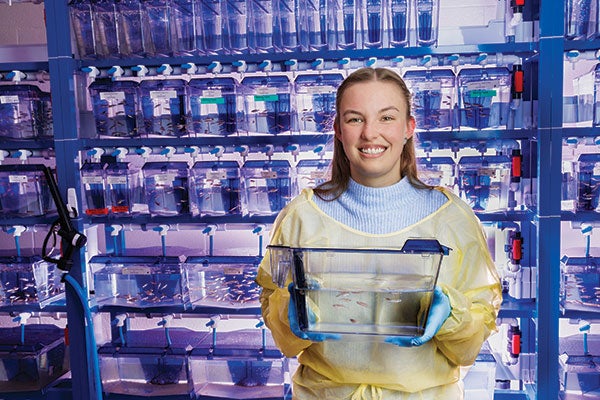
Pharmacology and toxicology doctoral student Kathryn Lorbacher is studying the regenerative properties of zebrafish to better understand central nervous system injuries and possible treatments. (Photo by Steven Mantilla)
The transformation has been decades in the making, with faculty as its architects. Programs such as the Faculty Research Startup Program have helped attract and retain researchers committed to ECU’s mission, offering seed funding and support systems that allow scholars to jump start pursuit of ambitious questions within the first three years after joining ECU.
Mary Farwell, assistant vice chancellor for research development, points to these efforts as foundational. “Research-active faculty have built the base of this achievement,” she says. “They’ve expanded our research portfolio and pushed us to this milestone — not by chasing rankings, but by staying true to our mission.”
One of those faculty members is Jessica Cooke Bailey, a researcher in the ECU Department of Pharmacology and Toxicology. A transplant from another R1 university, Bailey says ECU’s values were the draw. “I came here because I saw the opportunity to do research that serves the region,” she says. “Now, with the R1 designation, we can attract even more students and faculty who want to do work that matters.”
At ECU, the next generation of researchers isn’t confining its learning to classrooms alone. Research experiences put students directly into the lab, field and community. “Faculty with active research programs bring the latest discoveries into the classroom, enriching coursework with cutting-edge knowledge. Earning a degree from an R1 university signals that students entering the workforce are critical thinkers with technical skills to make a contribution to their employer on day one,” says Paynter.
Programs such as Course-based Undergraduate Research Experiences are also helping ECU build a pipeline of future scientists, scholars and innovators prepared to excel in their fields. These engaging opportunities build advanced skills, and collaborating with peers and mentors often helps shape students’ next steps.
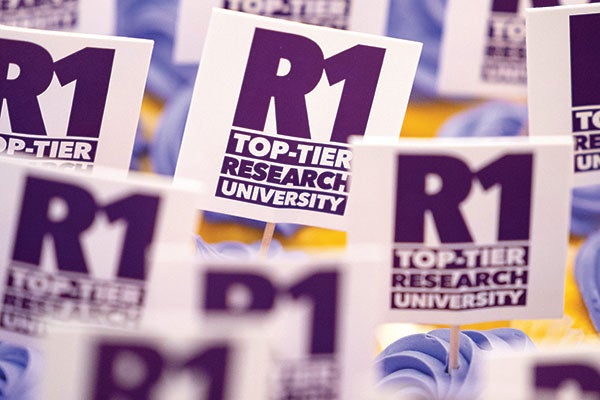
What is R1?
The R1 research classification identifies U.S. universities that demonstrate the highest levels of research activity as designated by Carnegie Classifications of Institutions of Higher Education and the American Council on Education.
To achieve R1 status, an institution must award at least 70 research doctorates and spend a minimum of $50 million on research and development annually.
ECU is now part of the top 5% of research institutions across the country designated as R1 and one of only five in North Carolina.
Lovens Paul, a biochemistry major studying fruit fly stem cells, puts it simply. “I love doing research. It helps me think critically, ask new questions and find ways to answer them,” he says. His curiosity echoes throughout the university, where researchers across disciplines are testing ideas that may one day become breakthroughs.
Or take Maddi Craney, a fourth-year doctoral student studying cancer therapeutics. She’s already working on licensing and commercialization efforts to make those therapies available to patients.
And consider faculty members Bhiba Das of the College of Health and Human Performance and Adrienne Steiner-Brett of the School of Music, whose interdisciplinary project merges kinesiology and music therapy in a virtual clinic for caregivers — a fusion of science and humanity grounded in ECU’s mission of service.
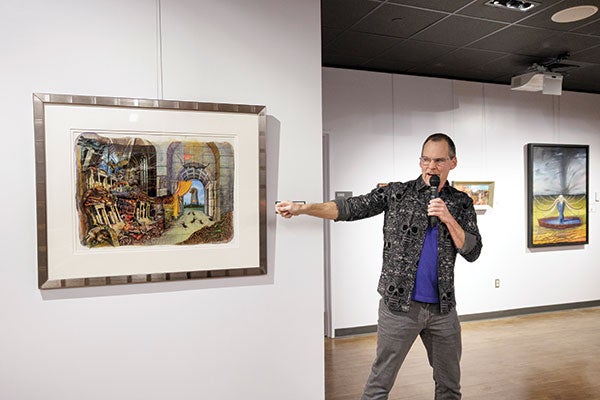
Scott Eagle, associate professor of art in the School of Art and Design, points out details in his original artwork for Jeff VanderMeer’s 2008 novel, The Situation. The pair have collaborated on VanderMeer’s books for years. Eagle’s artwork has also been displayed at the U.S. Embassy in Beijing and the British Library in London and featured by the Pera Museum in Istanbul. (Photo by Steven Mantilla)
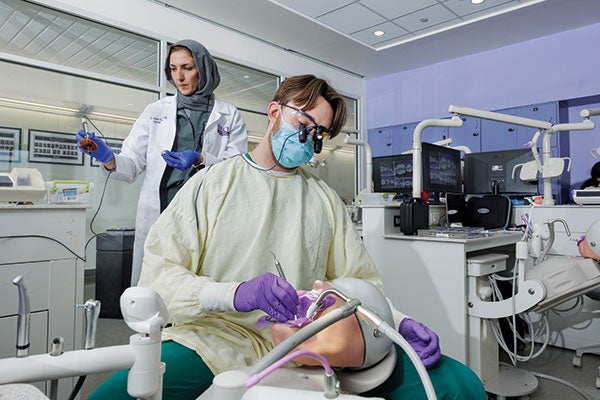
Dental student Tanner Butzin works on restorative dental techniques in the sim lab while faculty member Dr. Hanan Elgendy observes. (Photo by Steven Mantilla)
Reimagining the American research university
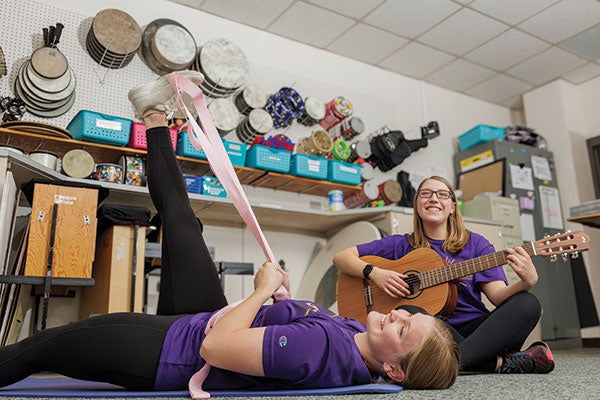
ECU undergraduates Kensey Tarkington, left, and Abby Ortiz demonstrate the yoga and music therapy they use during the virtual study sessions they lead with informal family caregivers. (Photo by Steven Mantilla)
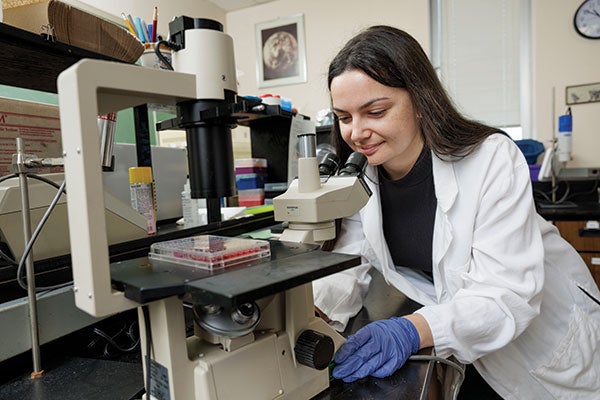
Maddi Craney, a doctoral student, is working in cancer therapeutics at ECU. (Photo by Steven Mantilla)
The R1 designation is not simply an internal validation; it’s a catalyst for broader economic and societal transformation. ECU’s expanding research activities have ripple effects across the region, bolstering biotech, improving rural health care and building new workforce pipelines. These efforts not only create high-paying jobs and strengthen local economies but also position North Carolina as a leader in critical fields such as biotechnology, coastal resilience and advanced manufacturing.
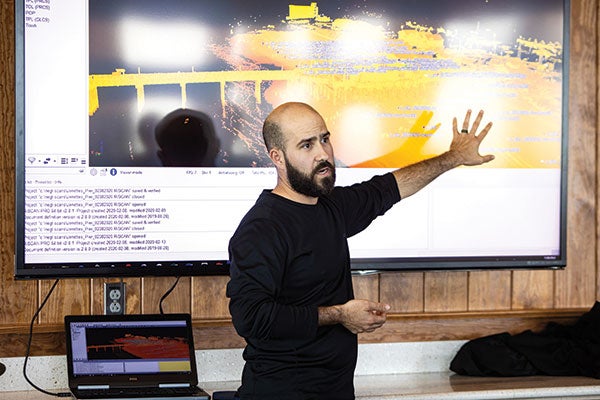
David Lagomasino, an associate professor of coastal studies, recently secured more than $1 million in grants to fund research projects aimed at strengthening coastal resilience. His work covers a broad spectrum of coastal issues, including sediment movement in Currituck Sound, the relationship between coastal ecosystems and cyclones, and dune restoration efforts along North Carolina’s coastline. (Photo by Rhett Butler)
Mark Phillips, executive director of the Eastern Regional Office for the North Carolina Biotechnology Center, sees it as a turning point. “ECU has long been a driver of economic growth in life sciences,” he says. “With R1 status, its impact on innovation and business development will only grow.”
Private-sector collaborators are already noticing. Steven LaFevers, vice president of global emerging technology at Hyster-Yale Group, notes the importance of faculty-student partnerships in preparing the workforce of tomorrow.
“What ECU is doing is aligning education with real-world needs,” he says. “That’s incredibly powerful.” Perhaps the most radical aspect of ECU’s rise is how it challenges traditional narratives about what a research university should be. The standard image — an ivy-covered campus in a wealthy ZIP code distanced from the public it serves — is crumbling. In its place stands a new model grounded in access and relevance.
At a time when public confidence in higher education is eroding, ECU is making the case for why it still matters. Its researchers aren’t confined to laboratories; they’re in local clinics, coastal communities, startup incubators and K-12 classrooms. Its students aren’t passive learners; they’re co-creators of knowledge. Its leaders aren’t chasing prestige; they’re redefining it.
“In the future, every R1 is going to aspire to be ECU,” Mitchell said.
It may sound like hyperbole, but a closer look reveals a constellation of national awards for public service, an infrastructure built for engagement, a faculty anchored by mission and a student body that reflects the communities it serves.
This is not just a story of one university’s ascent. It’s the story of what’s possible when research, education and service are not treated as separate pillars but as interlocking gears in a larger machine. At ECU, that machine is humming, spinning and lifting the region — and the nation — with it.
Doug Boyd contributed to this article.
